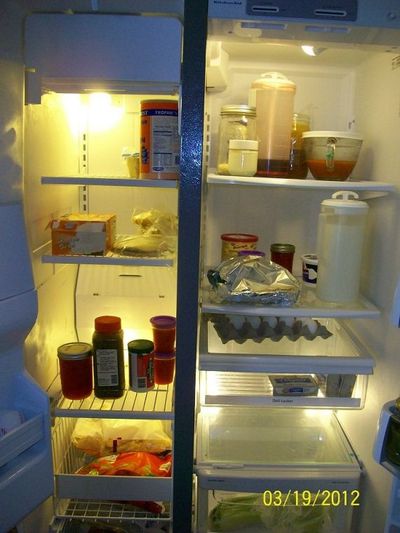Saturday July 14th, 2012
Often the most energy efficient alternative makes financial sense but not all the time.
Replacing incandescent appliance bulbs with LED: My fancy side-by-side energy star refrigerator has five 40-watt incandescent bulbs inside. 3 in the fridge and 2 in the freezer. Admittedly, I obsess a little bit each time I open up the door for a few seconds and see the incandescent bulbs burning away and heating up. Not only am I paying for the electricity to light 5 very inefficient bulbs but also the electricity to run the compressor in the refrigerator to remove that heat.
I imagine that this is very much, a negligible amount of electricity. But I can't conclusively say one way or the other. Let's experiment!!
For arguments sake, assume that both the fridge and freezer doors are opened up for 10 seconds at a time, 10 times a day (10 x 10 = 100 seconds a day).
There are three 40-watt bulbs in the fridge and two 40 watt bulbs in the freezer.
For both the fridge and freezer that works out to be:
5 bulbs X 40 watts = 200 Watts x 100 seconds / 3600 seconds/hour = 5.55 watt-hours/day
5.55 watt-hours/ day x 365.25 days = 2029 watt-hours/year or about 20 cents worth in electricity.
There is also the additional energy from the bulbs heating up the inside of the refrigerator that must be removed. That too takes electricity.
Looking up the efficiency rating of refrigerators, most energy star refrigerators are pretty efficient. Let's assume they consume 100 watts to remove 100 watts of heat. Some are worse and some in the 5-star rating category are actually even more efficient.
So from the incandescent light bulbs alone, 4.058 kWh of energy is consumed each year when opening and closing the refrigerator doors. At 11 cents per kWh, that is about 45 cents per year.
CFL’s are cheap but they are pretty much useless in the cold. Then there are LED lights. They are still kind of expensive for household lighting but they are quickly becoming the superior choice for all lighting needs.
If five 4 watt LED lights were used instead of 40 watt incandescent bulbs, they would consume 10 times less energy, using about 4.5 cents/year in electricity.
Replacing incandescent lights with LEDs (even though they are 10 times more efficient) would save a very trivial 40 cents per year in electricity (at 11 cents/kWh).

LED lights in my refrigerator that replaced 5 incandescent bulbs.
The five 4-watt (40 watt equivalent) LED bulbs on eBay run about $5.70 each. 5 x $5.70 = $28.50. A 40 cent/year savings would take over 71 years to pay off the LED bulbs.
Rule#1: Save energy without sacrificing convenience and luxury.
Rule#2. The efficiency improvement must save enough energy overtime to pay for the expense of making the improvement.
This is violation of rule #2 and hardly worth going through this exercise. But at least now we know.
At the cost of $28.50, I no longer obsess over incandescent bulbs in the fridge anymore.
Update 3/21/2108: Wow! LEDs were really expensive back then. Let's re-run the cost analysis using today's prices of LED bulbs:
A 40 watt-equivalent LED bulb today (in 2018) costs about $1.29. So 5 bulbs would cost 5 x $1.29 = $6.45. At 40 cents/year savings it would take 16 years. That's still a long ROI but it's better than 71 years. I think not having the hassle of having to dig to the back of the fridge/freezer to replace a burnt out incandescent appliance bulb makes it worth it.
